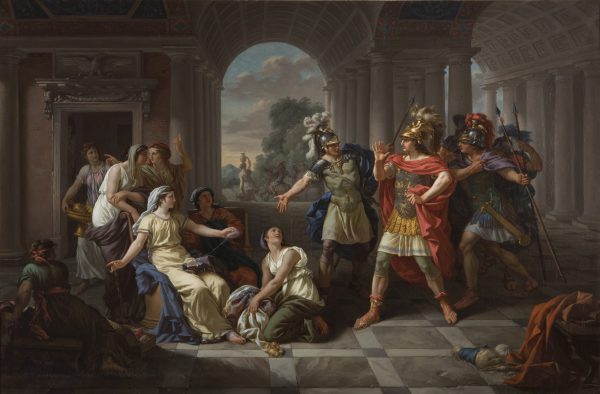Tarquin’s Sons Admiring Lucretia’s Virtue, 1781
Oil on canvas, H. 1.28 m; W. 1.94 m
Signed and dated lower centre: J. J. Lagrenée 1781.
Provenance: Private collection, France.
- Jean Locquin, La peinture d’histoire en France de 1747 à 1785, Paris, 1912, p. 252 and 255.
- Louis Hautecoeur, Histoire de l’art, 1959, p. 56.
- Bukdahl, II, 1982, p. 225 and 309 (reference).
- Marc Sandoz, Les Lagrenée, II. – Jean-Jacques Lagrenée (le jeune), 1739-1821, Paris, 1988, p. 226-227, no. 135 (as location unknown).
This painting which is exceptional for its large size and excellent condition shows a theme that was rarely painted. It is a legend from the early days of Ancient Rome, told by Livy. In 509 B.C. the king, Tarquin the Proud besieged the city of Ardea. His son Sextus, who was a lover of orgies and debauchery brought a few companions to Rome to verify the behaviour of their wives. They found the king’s daughters-in-law enjoying themselves with numerous companions. Only one, Tarquinius Collatinus found his wife Lucretia, famous for her beauty and even more so for her virtue, was quietly spinning wool and watching over her home. Lagrenée has described the moment when Sextus sees her, and is stupefied by this exemplum virtutis. The tragic end of the legend is well known: the rape and suicide of Lucretia.
The choice of this subject from ancient history is typical for the time. From 1775, such themes became much more common with a preference given to episodes from Roman history (especially the period of the Republic, see Jean Locquin, La peinture d’histoire en France de 1747 à 1785, Paris, 1912, p. 251). According to Marc Sandoz, the importance of our painting suggests that it was commissioned but there is no proof of this (Marc Sandoz, Les Lagrenée, II. – Jean-Jacques Lagrenée (le jeune), 1739-1821, Paris, 1988, p. 226).
Jean-Jacques Lagrenée the Younger played an important part in the renewal of history painting during the second half of the 18th century. He was from the same generation of painters as Lépicié, Brenet, Durameau and Doyen. Lagrenée was a pupil of his brother Louis who was twelve years older than him. After winning the second Grand Prize for Rome in 1760, he left with Louis for Russia that year but returned to Paris following the Empress’s death in 1762. He spent the years 1763 to 1769 in Italy and in 1768 – despite not having won the first prize – earned the favour from Marigny of being included for a year as a pensionnaire at the French Academy in Rome. During his time in Italy, he became fascinated by Antiquity. He became an agréé at the Académie Royale in 1769 and from 1771 to 1804 he exhibited regularly at the Salon. In 1775, he was admitted as a full member of the Académie with a painting of Winter for the Apollo Gallery at the Louvre as his reception piece. He was appointed assistant professor the next year and full professor in 1781.
An innovative artist, Lagrenée the Younger was a decorator who was sought after for his ceilings. He became one of the main ceiling painters of his time with Barthélemy, Durameau and Callet. He was interested in the friezes of Greek temples, paintings in ancient baths and Etruscan vases. As his career progressed, the vocabulary of forms he used simplified, became sparser, giving his frieze decorations a monumental appearance. In this way he was one of the precursors of the Adam and Empire styles. This new taste led to his selection as artistic director of the Sèvres factory (1785-1800). His interest in new artistic techniques led him to original experimentation: he engraved using the aquatint technique and also painted on glass and invented a process for working with marble. In the area of drawing, he became a specialist in highlighting bistre wash or watercolour with gold. His paintings, large numbers of which were produced, are varied and were first marked by chiaroscuro and Bolognese 17th century academism. From the 1780s, inspiration from Antiquity becomes more apparent along with his taste for the picturesque which led him to evocations of ordinary life in antiquity.
Our painting shows two groups of figures in the foreground, placed similar to a stage, in an architectural space with sparse Doric decoration that confirms Lagrenée’s taste for Antiquity. Like in Raphael’s art, the architecture frames a view to the countryside. Despite the artificiality of such a setting, the precision of the poses that correspond to the feelings and actions described in the legend is admirable. The great quality of the draperies and lustre of their colour are also noticeable.
Among the models and references Lagrenée must have had in mind when creating his composition, Charles Le Brun’s famous manifesto for classicism in French painting, Alexander in the Tent of Darius (1660, Chateau of Versailles), deserves mention. Of course, the decorative lightness of Boucher’s century which characterizes our work distinguishes it from Le Brun’s composition. Nevertheless the design is of a theatre stage. In a similar classical spirit, Lagrenée has represented the sentiments at their height and focused on the variety of expressions.
